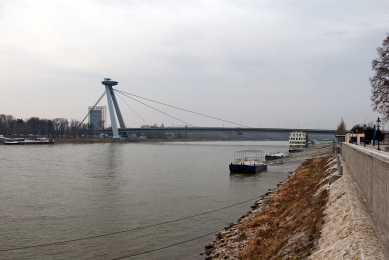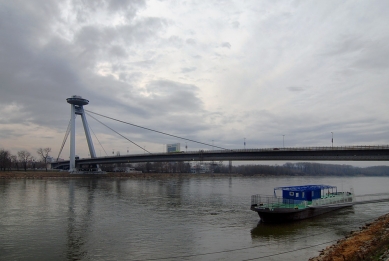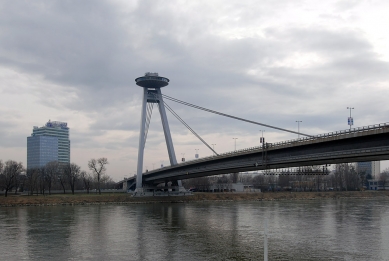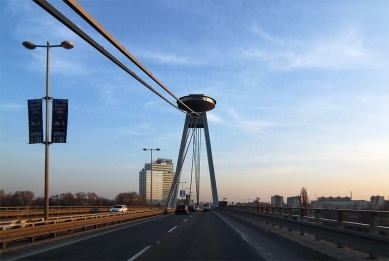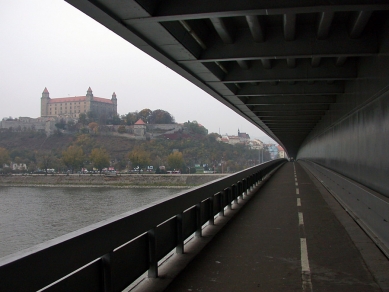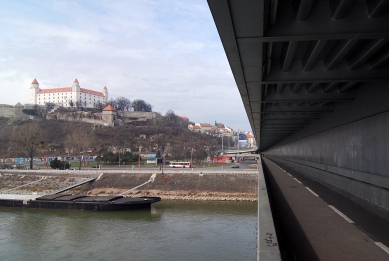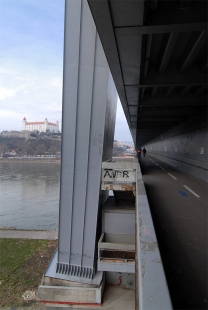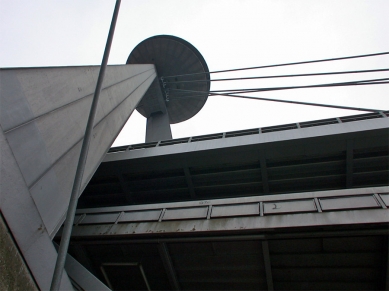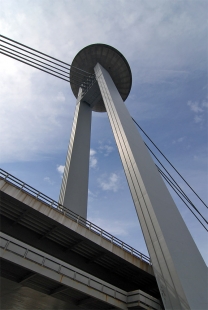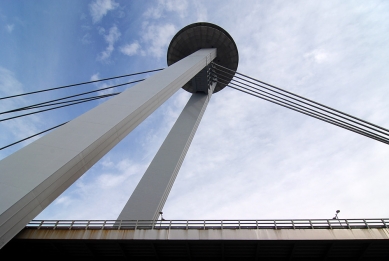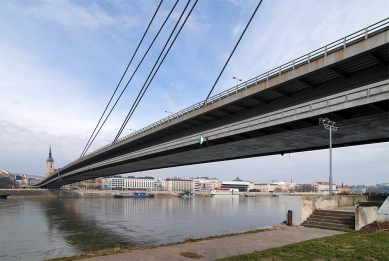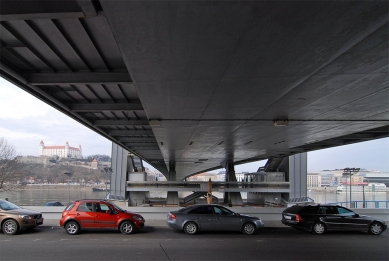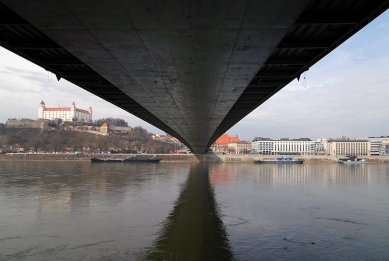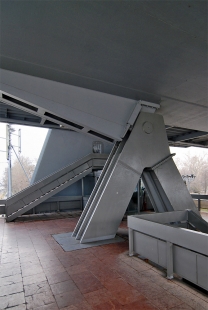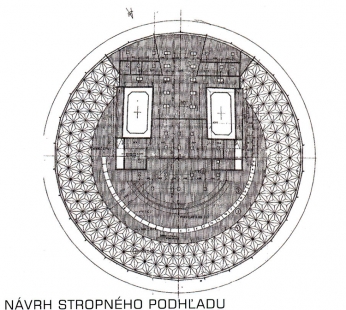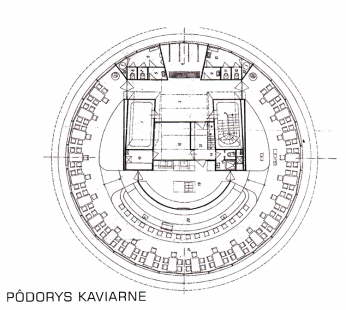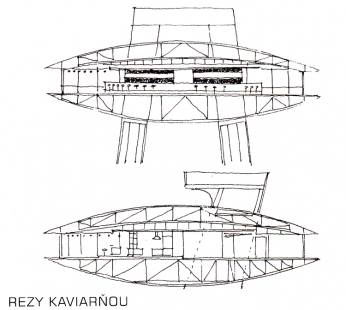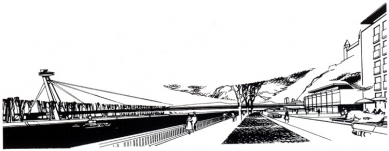
New Bridge

Identity means sameness. But it is a vague word that has multiple meanings, sometimes even contradictory ones. In mathematics and logic, it signifies complete identity; philosophers - allegedly the first among them was the pedant Leibniz - found that complete identity is only possible with a single, unique thing, so two things cannot be absolutely identical. More recent philosophers (Heidegger, Derrida) contributed further complications, as did psychology and sociology. After all, what a peculiar phenomenon is the identity of the old Prešpurans, which not only completely disappeared for a time but was then adopted by a completely new generation?
You could say that discussing identity in relation to the architecture of the New Bridge in Bratislava (architects Jozef Lacko, Ladislav Kušnír, Ivan Slameň, structural engineer Arpád Tesár, 1972) is out of place. For by identity, we usually understand the historically formed uniqueness of each place; and such a bold and relatively recent work cannot possibly fit into that picture. Identical is associated with the romantic and the ancient. The modern cannot be romantic, and certainly not ancient. It relates to the categories of archetype and genius loci, which also refer to the long past. In antiquity, the fact of some further emergence disappears, the paradox of rising from nothing, the novelty, the unusualness of what did not yet exist recently and today exerts its totality and physical existence.
Reflections on identity surely did not concern anyone during the building years of the fifties and sixties when the construction of the new Bratislava bridge over the Danube was decided. It was to be the second city bridge, hence it was later named New, to replace the original name of SNP, with which it had nothing in common. Indeed, it has been popularly referred to as new from the very beginning to this day.
They discussed whether to build it where the access points would affect the old buildings, but ultimately they decided on this location - it seemed appropriate for the city at that time. However, the demolition of historical buildings was considered unfortunate, but the voices of preservationists and conservative lovers of antiquities were taken as hostile in that innovative era focused on bright tomorrows. Since then, the bridge has also been understood as a disruption of the original identity of historical Bratislava.
However, it should be emphasized that the architectural figure of the bridge responds formatively to this conflict. The historically rich figure of the city and castle on the left bank of the river with tall landmarks was considered so important by the authors that they did not erect any competitive structure on the Bratislava side. The slanted pylon is a gesture that does not disrupt the historical urban context; it contrapuntally moves away from the city while simultaneously refusing to remain in the background.
The architectural form of the bridge, however, also arose in broader contexts. The liberalization brought by the sixties allowed us to develop the principles of pre-war modernism, and the strong first domestic generation of architects internally identified with it. Moreover, the typically Slovak ease and detachment from traditions resembled socialist ideology at least in its prospectiveness. The contemporary conviction included an idea of radical innovations and intoxication from major construction works - the bridge distinctly has two inseparable aspects in the connection of architecture and construction. The chief architect of the bridge, Jozef Lacko, was already 49 years old at the time of the competition. The design of the steel bridge (he finished fourth in the competition behind the reinforced concrete constructions) distinctly diverged from his previous works. It was a reflection of a new era, which the experienced architect knew how to reflect and identify with, undoubtedly with the significant participation of two younger colleagues Ladislav Kušnír and Ivan Slameň.
The qualities of the bridge are not only purely architectural and compositional or solely structural, as conceived by Arpád Tesár. There, where it seems that the architects created a solution independent of the structure, its construction is also respected.
The New Bridge is one of the unique works of bridge engineering on a global scale. Its span over the river is 303 meters. Originally it was 21 m wide, now, after railing adjustments, it is one meter wider. The pylon is 90 m tall. The bridge still holds the world record in span (total 448 m) for bridges with a single plane of suspension and one pylon.
The bridge has become so popular that it has even appeared in the logos of some Bratislava companies. It is repeatedly written about as a remarkable piece. It established a new or developed and enriched an older identity of Bratislava. This identity, meaning the city's sameness with itself, simultaneously constitutes its clear distinctiveness from other cities. In a complex time and with a complicated genesis, a work has emerged that builds the identity of the Slovak metropolis. Today, competing constructions are emerging around it, which suppress its pioneering isolation. Identity is shaped not only by deep historical layers but also by the present. It seems that the gap between the new and the historical (ancient) is not actually so very deep.
History
It was built between 1967 and 1972 by the companies Doprastav Bratislava and Hutné montáže Ostrava according to the project of architects Jozef Lacko, Ladislav Kušnír, Ivan Slameň, Arpád Tesár, and Jozef Zvara. It was put into use on August 26, 1972.
Due to its construction, a significant part of Bratislava's Podhradie was demolished, so it was received with disquiet by many Bratislavans. However, it significantly accelerated transportation and thereby the development of the Petržalka housing estate.
In 2005 and 2006, due to severe pollution, a protective coating was made on the footbridges for pedestrians and cyclists. In 2006, both pylons were also coated with a protective layer.
Parameters
The bridge is steel and suspended on a single pylon that is 84.6 m high. Total length: 430.8 m, main length between pillars 74.80 m - 303 m - 54 m, width 21 m, weight 7,537 t, total height from foundations to top 95 m, diameter of the dome 32 m. The bridge has two two-lane roadways for cars, and below them is a sidewalk for pedestrians and cyclists on each side of the bridge.
The New Bridge ranked fourth in the world in its category of suspended bridges immediately upon its opening in 1972. In the narrower category of suspended bridges, that is, bridges with only one pylon and only one suspension plane, it still holds the world record to this day. It ranks third among bridges with a slanted pylon.
Interesting Facts
A unique attraction is the restaurant at the top of the pylon at a height of 85 m (after reconstruction since 2005 named UFO watch.taste.groove, formerly known as Bystrica). It is connected to an observation platform, from which there is a view of 100 km. An elevator leads to it in the left pylon of the bridge, while an emergency staircase with 430 steps is located in the right pylon. The UFO is considered one of the city's landmarks and a sought-after destination for both local and foreign tourists, attracting 200,000 visitors each year. [2]
The bridge contains a water pipeline supplying the Old Town from Petržalka.
During the construction of the bridge, a problem arose when an error in the static calculation was discovered, necessitating the bridge to be secured with additional support on the left bank, which reduced its main span to 303 meters.
The lighting of the bridge was originally addressed with 3,000 lights on the railings; in 1998 it was replaced with pole lighting with 52 special lamps.
You could say that discussing identity in relation to the architecture of the New Bridge in Bratislava (architects Jozef Lacko, Ladislav Kušnír, Ivan Slameň, structural engineer Arpád Tesár, 1972) is out of place. For by identity, we usually understand the historically formed uniqueness of each place; and such a bold and relatively recent work cannot possibly fit into that picture. Identical is associated with the romantic and the ancient. The modern cannot be romantic, and certainly not ancient. It relates to the categories of archetype and genius loci, which also refer to the long past. In antiquity, the fact of some further emergence disappears, the paradox of rising from nothing, the novelty, the unusualness of what did not yet exist recently and today exerts its totality and physical existence.
Reflections on identity surely did not concern anyone during the building years of the fifties and sixties when the construction of the new Bratislava bridge over the Danube was decided. It was to be the second city bridge, hence it was later named New, to replace the original name of SNP, with which it had nothing in common. Indeed, it has been popularly referred to as new from the very beginning to this day.
They discussed whether to build it where the access points would affect the old buildings, but ultimately they decided on this location - it seemed appropriate for the city at that time. However, the demolition of historical buildings was considered unfortunate, but the voices of preservationists and conservative lovers of antiquities were taken as hostile in that innovative era focused on bright tomorrows. Since then, the bridge has also been understood as a disruption of the original identity of historical Bratislava.
However, it should be emphasized that the architectural figure of the bridge responds formatively to this conflict. The historically rich figure of the city and castle on the left bank of the river with tall landmarks was considered so important by the authors that they did not erect any competitive structure on the Bratislava side. The slanted pylon is a gesture that does not disrupt the historical urban context; it contrapuntally moves away from the city while simultaneously refusing to remain in the background.
The architectural form of the bridge, however, also arose in broader contexts. The liberalization brought by the sixties allowed us to develop the principles of pre-war modernism, and the strong first domestic generation of architects internally identified with it. Moreover, the typically Slovak ease and detachment from traditions resembled socialist ideology at least in its prospectiveness. The contemporary conviction included an idea of radical innovations and intoxication from major construction works - the bridge distinctly has two inseparable aspects in the connection of architecture and construction. The chief architect of the bridge, Jozef Lacko, was already 49 years old at the time of the competition. The design of the steel bridge (he finished fourth in the competition behind the reinforced concrete constructions) distinctly diverged from his previous works. It was a reflection of a new era, which the experienced architect knew how to reflect and identify with, undoubtedly with the significant participation of two younger colleagues Ladislav Kušnír and Ivan Slameň.
The qualities of the bridge are not only purely architectural and compositional or solely structural, as conceived by Arpád Tesár. There, where it seems that the architects created a solution independent of the structure, its construction is also respected.
The New Bridge is one of the unique works of bridge engineering on a global scale. Its span over the river is 303 meters. Originally it was 21 m wide, now, after railing adjustments, it is one meter wider. The pylon is 90 m tall. The bridge still holds the world record in span (total 448 m) for bridges with a single plane of suspension and one pylon.
The bridge has become so popular that it has even appeared in the logos of some Bratislava companies. It is repeatedly written about as a remarkable piece. It established a new or developed and enriched an older identity of Bratislava. This identity, meaning the city's sameness with itself, simultaneously constitutes its clear distinctiveness from other cities. In a complex time and with a complicated genesis, a work has emerged that builds the identity of the Slovak metropolis. Today, competing constructions are emerging around it, which suppress its pioneering isolation. Identity is shaped not only by deep historical layers but also by the present. It seems that the gap between the new and the historical (ancient) is not actually so very deep.
Matúš Dulla
The New Bridge (originally Most SNP) is a single-pylon, steel, road, suspended bridge with a fan-shaped design over the Danube in Bratislava. It is the only bridge in Bratislava that has no pillar in the flow of the Danube, making it the bridge with the largest main span in Bratislava and thus generally classified as the largest in the city. In 2001, it was declared the building of the century in Slovakia in the category of bridge structures. The bridge is part of the World Federation of Great Towers association, being the 28th and lowest structure in this association and simultaneously the only structure in this association that serves as a pylon for the bridge.
The New Bridge (originally Most SNP) is a single-pylon, steel, road, suspended bridge with a fan-shaped design over the Danube in Bratislava. It is the only bridge in Bratislava that has no pillar in the flow of the Danube, making it the bridge with the largest main span in Bratislava and thus generally classified as the largest in the city. In 2001, it was declared the building of the century in Slovakia in the category of bridge structures. The bridge is part of the World Federation of Great Towers association, being the 28th and lowest structure in this association and simultaneously the only structure in this association that serves as a pylon for the bridge.
History
It was built between 1967 and 1972 by the companies Doprastav Bratislava and Hutné montáže Ostrava according to the project of architects Jozef Lacko, Ladislav Kušnír, Ivan Slameň, Arpád Tesár, and Jozef Zvara. It was put into use on August 26, 1972.
Due to its construction, a significant part of Bratislava's Podhradie was demolished, so it was received with disquiet by many Bratislavans. However, it significantly accelerated transportation and thereby the development of the Petržalka housing estate.
In 2005 and 2006, due to severe pollution, a protective coating was made on the footbridges for pedestrians and cyclists. In 2006, both pylons were also coated with a protective layer.
Parameters
The bridge is steel and suspended on a single pylon that is 84.6 m high. Total length: 430.8 m, main length between pillars 74.80 m - 303 m - 54 m, width 21 m, weight 7,537 t, total height from foundations to top 95 m, diameter of the dome 32 m. The bridge has two two-lane roadways for cars, and below them is a sidewalk for pedestrians and cyclists on each side of the bridge.
The New Bridge ranked fourth in the world in its category of suspended bridges immediately upon its opening in 1972. In the narrower category of suspended bridges, that is, bridges with only one pylon and only one suspension plane, it still holds the world record to this day. It ranks third among bridges with a slanted pylon.
Interesting Facts
A unique attraction is the restaurant at the top of the pylon at a height of 85 m (after reconstruction since 2005 named UFO watch.taste.groove, formerly known as Bystrica). It is connected to an observation platform, from which there is a view of 100 km. An elevator leads to it in the left pylon of the bridge, while an emergency staircase with 430 steps is located in the right pylon. The UFO is considered one of the city's landmarks and a sought-after destination for both local and foreign tourists, attracting 200,000 visitors each year. [2]
The bridge contains a water pipeline supplying the Old Town from Petržalka.
During the construction of the bridge, a problem arose when an error in the static calculation was discovered, necessitating the bridge to be secured with additional support on the left bank, which reduced its main span to 303 meters.
The lighting of the bridge was originally addressed with 3,000 lights on the railings; in 1998 it was replaced with pole lighting with 52 special lamps.
The English translation is powered by AI tool. Switch to Czech to view the original text source.
1 comment
add comment
Subject
Author
Date
skica
Jana
17.11.19 06:56
show all comments


